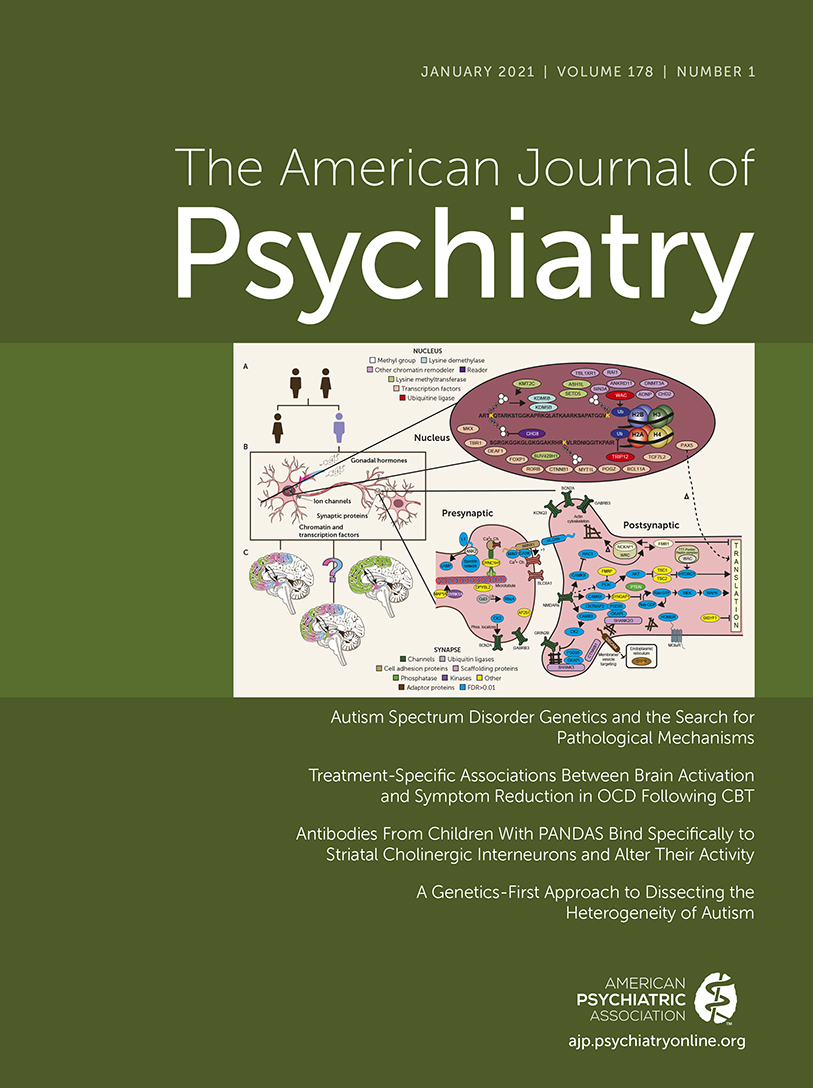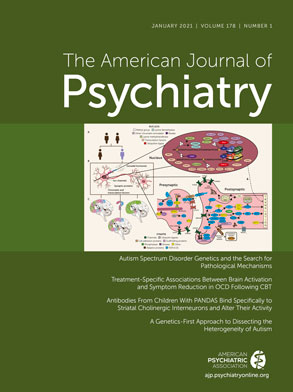Autism is a highly heritable disorder, with worldwide heritability estimates between 50% and 80%, indicating a strong genetic contribution to this disorder (
1). There is high phenotypic heterogeneity, with considerable variability in the clinical presentation in terms of symptom profile, cognitive function, and developmental trajectories as well as high rates of comorbidity with neurodevelopmental delay and other psychiatric diagnoses (see, for example, Loucas et al. [
2]). A large number of studies have now identified specific genetic variants and genes contributing to autism risk and unraveled the highly complex genetic architecture of this disease, which includes contributions from de novo mutations, rare inherited variants, and common polygenic variation (
3–
5). This success can be attributed to the advent of affordable and reliable genome sequencing technologies, the creation of large data sets, and international collaborations. The hope is thus high that genetic factors can be used to guide prevention, treatment, and prognosis of the disease. While the number of genetic variants and genes known to contribute to autism risk is ever growing, it is less clear how the complex genetic risk factors correlate with the variable phenotype, making strategies to use genetic information for clinical use challenging. Two articles in this issue highlight the challenges of mapping the heterogeneity in the clinical presentation of autism to specific genotype-phenotype relationships.
Chawner et al. (
6) focus on large copy number variants (CNVs) that have previously been reported to significantly increase risk for autism, specifically deletions and duplications on chromosomes 16p11.2 and 22q11.2. To dissect the phenotypic heterogeneity that can be attributed to these four different CNVs, the authors used a genetics-first approach, based on a large international cohort ascertained on the basis of a medical genetic diagnosis. The phenotype variability in this genetics-first cohort was then compared with a large phenotype-first cohort, ascertained on the basis of a clinical diagnosis of autism and excluding individuals carrying known risk CNVs. In the genotype-first cohort, the proportion of individuals with a clinical diagnosis of autism ranged from 23% for individuals with 22q11.2 deletions to 58% for individuals with 16q11.2 duplications, indicating that none of these CNVs are fully penetrant. However, among study subjects who did not fulfill criteria for a diagnosis, a substantial proportion still met the clinical cutoff in at least one of the diagnostic domains covered within the diagnostic instrument (47% to 90%). The authors then compared the symptom severity and presentation between these four genetic groups and observed that while genotype is associated with significant differences in autism severity, symptom domain profile, and cognitive profile, it only explains a small fraction of the variance (1%−20%, depending on the phenotype measures). On the other hand, phenotype variation is much higher within each CNV group.
These findings argue against the proposition that there is a strong genotype-symptom profile relationship for these variants. A relative lack of specific genotype-phenotype correlation is further supported by comparisons to the phenotype-first cohort, all of whom were documented noncarriers of large CNVs. While carriers of the four specific CNVs display statistically significant differences in average symptom severities as compared with the non-CNV carriers, there was still significant overlap in phenotype presentation between carriers and noncarriers. The authors conclude that their study provides support for a model whereby autism profiles of these genetically defined subgroups are distinct but highly overlapping.
As detailed above, Chawner et al. highlight phenotypic heterogeneity even within well-defined risk CNV carrier groups. However, it is clear that many more of these deleterious genetic variants influence disease risk. In fact, deleterious genetic variants, including CNVs, are identified in 15%−20% of individuals with autism, with over 120 genes and genomic loci associated with disease in the largest genome-sequencing study to date (
5). The fact that overall, autism is associated with an increase in CNV burden (
7) suggests that many more loci are likely implicated.
In the other autism genetics research report in this issue, Douard et al. (
8) set out to map the effects of rare deleterious CNVs on the cognitive and behavioral dimensions related to autism. Using genome-wide genotyping and whole-genome sequencing data, they catalog the presence of large deleterious CNVs over 50 kb in size in four large cohorts, two autism-specific and two community cohorts, focusing on those variants that lie in genes with a high probability of intolerance to loss of function (i.e., likelihood of being deleterious). For each individual in these cohorts, the sum of the probability of intolerance to loss of function across all identified deletions or duplications is mapped to cognitive, behavioral, and motor symptoms. The authors report that a higher score—that is, more CNVs in genes intolerant to loss of function—predicts a higher risk for autism and a lower nonverbal IQ, in both the autism and the nonselected cohorts. Given the high comorbidity of autism and neurodevelopmental delay, it is important to note that a substantial proportion of autism risk by these cumulative measures is influenced by their effect on nonverbal IQ, and more strongly so for deletions than duplications. The authors also investigate the cumulative effects of deleterious CNVs on social responsiveness, behavioral and emotional symptoms, language, and phonological memory as well as adaptive and motor skills and epilepsy. While the sum of probability of intolerance to loss of function for deletions was associated with effects in all these domains, this again was strongly moderated by effects on nonverbal IQ. In contrast, duplications had more specific phenotypic associations, with the strongest effects on motor skills and no effects on language. Overall, this shows that there is a general phenotypic profile that is associated with the number of deleterious deletions and duplications irrespective of their genomic locus. In fact, model estimates in this study suggest that any large (1 Mb) coding deletion or duplication across the genome should increase autism susceptibility, with median odds ratios of 1.6 and 1.3, respectively. The specific genes included in the CNVs may thus mostly influence the effect size but not the profile of symptoms. The authors indeed offer an online tool (
https://cnvprediction.urca.ca/) that clinicians can use to estimate the effect size of CNVs measured in their patients, but this does not allow prediction of the specific symptoms of the individual who carries the CNV. Overall, this study supports the extreme polygenicity of autism with clear gene dosage effects—that is, the more deleterious CNVs, irrespective of genetic locus, the more symptoms. It also shows that the effects of deleterious deletions on autism risk may be explained in part by their effects on nonverbal IQ.
Overall, these two studies highlight the fact that although important progress has been made in autism genetics, there are still important limitations in their clinical application. While CNVs—both specific ones and the total number of deleterious CNVs—are predictive of autism, individual genotypes are not sufficiently specific in predicting symptom subtypes. Thus they cannot inform early interventions targeting the specific symptom combinations and developmental trajectory of each patient in the context of precision medicine. It is clear that additional factors need to be included in such predictive algorithms, including sex and environmental variables, as well as other types of genetic factors, ranging from deleterious single-nucleotide variants to common polygenic risk factors, which in turn can moderate the phenotypic impact of rare genetic factors (
9).
Finally, to date, no genes have been identified that, when mutated, exclusively confer autism risk and not also risk for intellectual disability or other neurodevelopmental disorders. This would question the possibility of developing truly autism-specific genetic test panels. As discussed by Myers et al. (
10), this raises the question as to whether genotype-phenotype relationships should be evaluated specifically for individual neurodevelopmental or neuropsychiatric diagnoses, or whether these diagnoses should be thought of as manifestations of underlying developmental brain dysfunction and thus investigated together. This would allow for the exploration of variation in phenotype expression in the context of pathogenic genetic variants across current diagnostic boundaries. In fact, this approach would be more consistent with the reported etiologic heterogeneity within each of these disorders, despite the overlapping symptoms and high rates of comorbidity as well as shared genetic and environmental risk factors. Approaches that are more inclusive in relation to genotype as well as the phenotype are needed for further progress in mapping genotype-phenotype relationships in autism.

